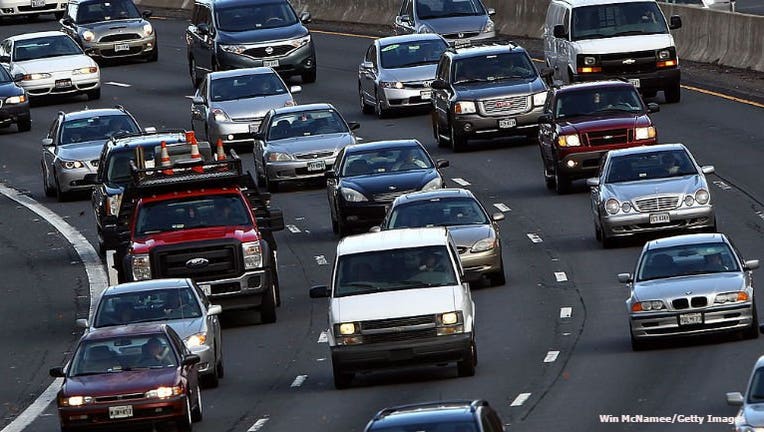Passenger vehicle travel rebounds to pre-pandemic levels

NEW YORK - Americans may be rounding a corner — literally — in their response to the coronavirus pandemic.
The number of daily passenger vehicle trips has hit a major milestone, reaching pre-pandemic levels for the first time in a year, according to data provided to The Associated Press by the transportation analytics firm Inrix, with Americans driving more often and farther than at any time since pandemic lockdowns were invoked.
The rise in vehicle travel comes amid other encouraging health and economic indicators. Consumer spending and manufacturing have been picking up. Employers have been adding workers. Governors have been easing restrictions on indoor dining and social gatherings. More auto fuel is being purchased. The winter peak in COVID-19 cases has receded. And more than one-fourth of Americans have received at least one dose of a vaccine.
Some of the largest travel increases have occurred in rural, suburban and smaller metropolitan areas, Inrix transportation analyst Bob Pishue said.
In Pensacola, Florida, passenger vehicle miles traveled last April dipped to around 50% of the average levels of January and February 2020, before pandemic restrictions were imposed. The situation is significantly different this spring. On the weekend of March 20-21, passenger vehicle miles topped 150% of the pre-pandemic level, according to Inrix data.
"If you drove through downtown Pensacola a year ago, it was a ghost town — everything was closed," said Kaycee Lagarde, the city’s public information officer. "Now if you go downtown, it basically looks normal as far as the number of people being out."
Lagarde said the traffic surge appears to have been aided by tourists, who have returned to beaches that were temporarily closed last year.
In general, "higher travel is reflective of a good economy," said Tim Lomax, a research fellow at the Texas A&M Transportation Institute. "They are traveling for a purpose, whether that’s a job, retail or school."
Last spring, many vehicles got parked for an extended stay as governors and mayors issued stay-at-home orders, schools went virtual and work sites shifted from offices to homes as a precaution intended to slow the spread of the coronavirus. Passenger vehicle miles traveled plunged to almost half their pre-pandemic levels nationally, and declined even more in some of the largest cities with the greatest restrictions.
Less driving meant less money for state transportation departments, which rely heavily on motor fuel taxes. The American Association of State Highway and Transportation Officials had estimated agencies could face a $28 billion revenue loss over a five-year period.
But "we’re starting to see a rebound here from a travel standpoint, and that’s been very helpful," said association executive director Jim Tymon.
Passenger vehicle miles traveled have been climbing upward this month, reaching 112% of their pre-pandemic levels during the week ending March 19, according to Inrix, which compiles passenger vehicle traffic data from anonymous GPS signals, such as from cellphone apps.
Midsize cities, particularly in the South, have seen a resurgence. Passenger vehicle miles traveled topped 160% of their pre-pandemic levels for two straight weekends in Mobile, Alabama, and exceeded 125% of pre-pandemic levels on recent weekends in Fort Myers, Florida; Greenville, South Carolina; and Knoxville, Tennessee.
Traffic also is rebounding in some of the nation's largest cities, though more so on weekends than weekdays and not yet back to pre-pandemic levels.
Passenger vehicle miles traveled fell last April to around 40% of pre-pandemic levels in Washington, D.C. That rebounded to around 90% or greater the first three weekends of March, though it was still lower during weekdays.
Los Angeles, New York, San Francisco and Philadelphia show similar patterns, where the weekend traffic has rebounded higher than the weekday traffic. Passenger vehicle miles hit 99% of their pre-pandemic levels in Los Angeles on March 21 after falling to well below half their norm in late March 2020.
In New York City, they exceeded 90% of their previous levels on March 20-21; they were around one-third the normal a year ago.
FREE DOWNLOAD: Get breaking news alerts in the FOX6 News app for iOS or Android
In San Francisco, Inrix data shows that passenger vehicle miles traveled reached 88% of their pre-pandemic levels over the weekend of March 20-21, their highest mark since March 11, 2020.
While higher traffic volumes show "there is more economic activity happening," they also reflect a shift away from mass transit, said Jeff Bellisario, executive director of the Bay Area Council Economic Institute. In February, ridership on the Bay Area Rapid Transit rail system remained at just 12.5% of pre-pandemic levels, he said.
Bellisario can personally attest to the change in traveling behavior. Prior to the pandemic, he didn't own a car — instead riding public transit to get to work and biking or walking to go other places. But he hasn't taken the rails in a year. He now works from home, and bought a car to get around town.
"My vehicle miles traveled is definitely higher than it was pre-COVID-19," he said.
Featured
DHS: 1M WI residents have completed their COVID-19 vaccine series
More than one million Wisconsin residents have completed their COVID-19 vaccine series -- meaning they have received both doses of the two-dose vaccines.
Featured
Kroger commits $1M to fund for victims, survivors of warehouse shooting
Roundy’s Supermarkets, Inc., announced a donation of $1 million from The Kroger Co. Foundation to seed the Roundy’s Oconomowoc Distribution Center Victims and Survivor’s Fund.

Wisconsin virtual school sees ‘more enrollment’ amid COVID, nurse shortage
Health experts project a shortage of at least 1 million nurses in less than a decade, and Destinations Career Academy of Wisconsin is preparing the next generation of frontline workers.



